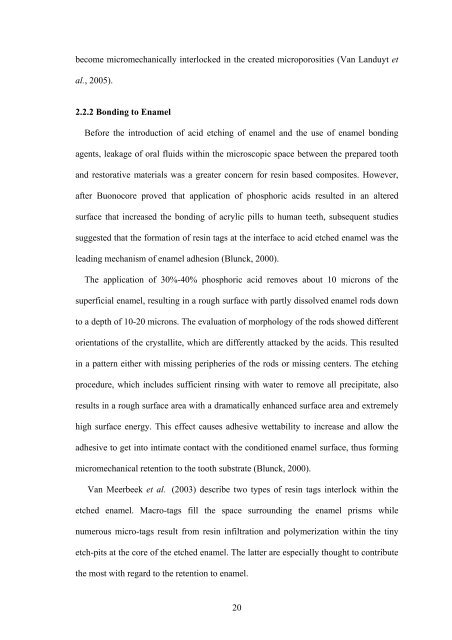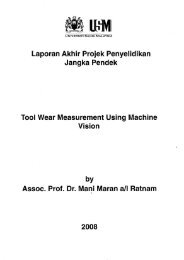microleakage in class ii composite restorations ... - ePrints@USM
microleakage in class ii composite restorations ... - ePrints@USM
microleakage in class ii composite restorations ... - ePrints@USM
You also want an ePaper? Increase the reach of your titles
YUMPU automatically turns print PDFs into web optimized ePapers that Google loves.
ecome micromechanically <strong>in</strong>terlocked <strong>in</strong> the created microporosities (Van Landuyt etal., 2005).2.2.2 Bond<strong>in</strong>g to EnamelBefore the <strong>in</strong>troduction of acid etch<strong>in</strong>g of enamel and the use of enamel bond<strong>in</strong>gagents, leakage of oral fluids with<strong>in</strong> the microscopic space between the prepared toothand restorative materials was a greater concern for res<strong>in</strong> based <strong>composite</strong>s. However,after Buonocore proved that application of phosphoric acids resulted <strong>in</strong> an alteredsurface that <strong>in</strong>creased the bond<strong>in</strong>g of acrylic pills to human teeth, subsequent studiessuggested that the formation of res<strong>in</strong> tags at the <strong>in</strong>terface to acid etched enamel was thelead<strong>in</strong>g mechanism of enamel adhesion (Blunck, 2000).The application of 30%-40% phosphoric acid removes about 10 microns of thesuperficial enamel, result<strong>in</strong>g <strong>in</strong> a rough surface with partly dissolved enamel rods downto a depth of 10-20 microns. The evaluation of morphology of the rods showed differentorientations of the crystallite, which are differently attacked by the acids. This resulted<strong>in</strong> a pattern either with miss<strong>in</strong>g peripheries of the rods or miss<strong>in</strong>g centers. The etch<strong>in</strong>gprocedure, which <strong>in</strong>cludes sufficient r<strong>in</strong>s<strong>in</strong>g with water to remove all precipitate, alsoresults <strong>in</strong> a rough surface area with a dramatically enhanced surface area and extremelyhigh surface energy. This effect causes adhesive wettability to <strong>in</strong>crease and allow theadhesive to get <strong>in</strong>to <strong>in</strong>timate contact with the conditioned enamel surface, thus form<strong>in</strong>gmicromechanical retention to the tooth substrate (Blunck, 2000).(Van Meerbeek et al., (2003) describe two types of res<strong>in</strong> tags <strong>in</strong>terlock with<strong>in</strong> theetched enamel. Macro-tags fill the space surround<strong>in</strong>g the enamel prisms whilenumerous micro-tags result from res<strong>in</strong> <strong>in</strong>filtration and polymerization with<strong>in</strong> the t<strong>in</strong>yetch-pits at the core of the etched enamel. The latter are especially thought to contributethe most with regard to the retention to enamel.20
















